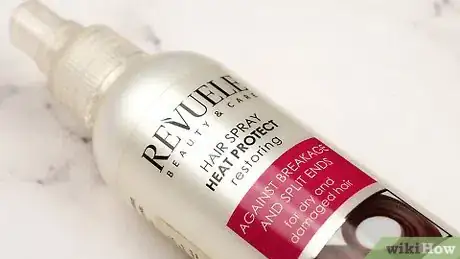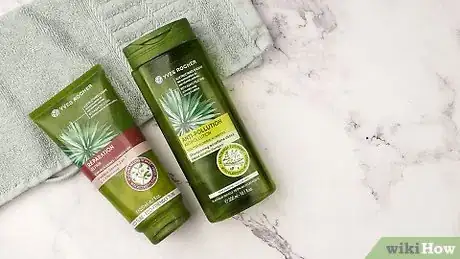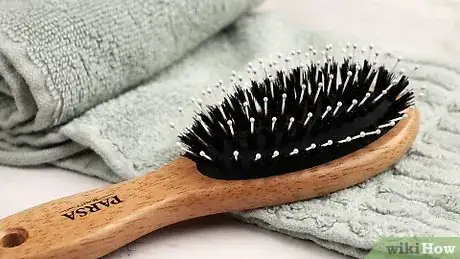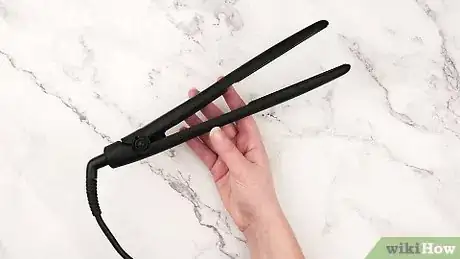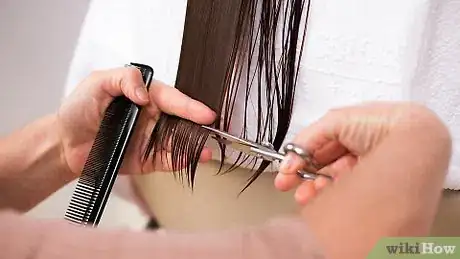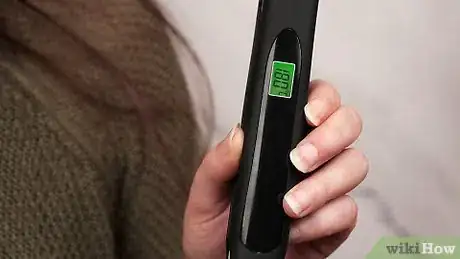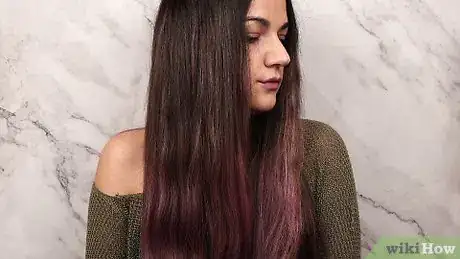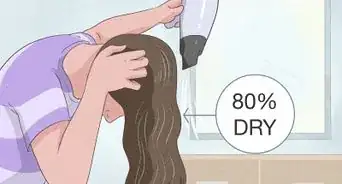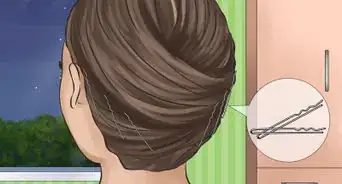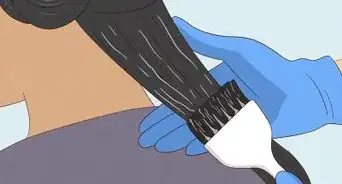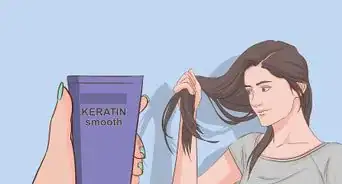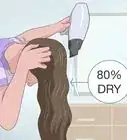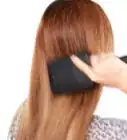This article was co-authored by Michael Van den Abbeel. Michael Van den Abbeel is a Professional Hair Stylist and the Owner of Mosaic Hair Studio and Blowout Bar in Orlando, Florida. He has been cutting, styling, and coloring hair for over 17 years. Michael loves showing his clients how to wash and wear their hair easily and effortlessly. Mosaic Hair Studio and Blowout Bar is recognized as a Diamond Top Tier level Wella salon.
There are 12 references cited in this article, which can be found at the bottom of the page.
wikiHow marks an article as reader-approved once it receives enough positive feedback. In this case, several readers have written to tell us that this article was helpful to them, earning it our reader-approved status.
This article has been viewed 312,782 times.
Straightening your hair can give it a smooth, sleek look. But do it too often without taking proper care of your locks, and you’ll be left with dry, heat-damaged hair that’s the exact opposite of what you were going for. It is possible to straighten your mane every day and keep it from turning into a frizzy mess. Some of the most important steps come before the flat iron ever hits your hair.
Steps
Buying the Right Products
-
1Purchase a heat protector. You will commonly find heat protector sprays made specifically for use with flat irons; there are also numerous creams and serums on the market, and some mousses contain heat protection.
- Some frequently recommended choices included Living Proof’s Straight Spray, Moroccan Oil (for thick or coarse hair), or products made with silicone.
-
2Buy a “smoothing” shampoo and conditioner. While these won’t make your hair straight, they can add moisture to your hair and therefore help to prepare it for the process of straightening.[1]
- Alternately, you may want to try a strengthening shampoo if you find that frequent straightening makes your hair weak
Advertisement -
3Get a new brush. Typical hairbrushes, which are made of nylon and plastic, cause static. But a brush made boar bristles and nylon will give your hair shape and polish and eliminate the fly-aways.[2]
-
4Consider a hair moisturizer. These products will help keep your hair healthy by increasing moisture. Since they may make your hair oilier or heavier, try using just once a week.
- Some options include Luster’s Pink Original Oil Moisturizer and Aveda’s Dry Remedy.
-
5Find a quality flat iron. A quality flat iron will be made of ceramic, tourmaline, or titanium. It should have multiple temperature settings so that you can choose what’s right for your hair’s texture and thickness.[3] These irons may be in the pricier range, but most very inexpensive flat irons only offer a single setting which is too high (usually 450 degrees) and will damage your hair with time.
- Ideally, you want to use a flat iron that has a temperature gauge with numbers rather than simple On, Off, Low, and High settings. This way you can gauge exactly how much heat your hair is getting.[4]
- Find an iron that is an inch and a half wide or smaller. Irons larger than that won’t be able to get closer enough to your scalp.[5]
- Ceramic plates ensure that the heat is evenly distributed across your hair as you straighten, and ceramic is good for most hair types and textures. Stay away from “ceramic coated” flat irons, which can dry out your hair.[6]
- If your hair is curly, however, you may need gold or titanium plates.[7]
Preparing Your Hair
-
1Keep hair trimmed. Damaged hair will only become more damaged as you put it through the daily straightening process, and you won’t be able to get the sleek look you’re after. If you’ve got split ends or inches of damage, start fresh by having your stylist cut them off.
- If you really don’t want to cut your hair, it may be possible to repair some damage over time with products containing oils and moisturizers. This is not a quick-fix, though—it could take two to three months to see improvements.[8]
-
2Wash your hair. Use your smoothing (or strengthening) shampoo and conditioner and rinse them well.
-
3Apply your heat protector. Depending on the product(s) you choose, you may need to apply it while your hair is still wet. Some products direct you to use them on damp hair, while others are for dry hair and you should apply them immediately before using the flat iron. Whatever the case, be sure to follow the directions on the packaging for best results.
- Use only as much product as you need for your specific hair type and length. Using too much product could result in hair that is weighed down and looks greasy, rather than sleek and shiny.
-
4Partially air/towel dry. Allowing your hair to air/towel dry for at least part of the time will reduce the amount of heat—and thus drying—endured by your hair. If you are able to straighten and style your hair to your satisfaction after allowing your hair to completely air/towel dry, this is a great option for reducing damage.
-
5Blow-dry your hair. Blow-drying your hair adds more heat, which can cause additional damage, but many people who straighten their hair also need to blow it dry to get the look they desire.
Straightening Your Hair
-
1Set the right temperature. To avoid damaging your hair, set the flat iron to the lowest temperature that will work for your hair. This temperature will depend on the specific qualities of your individual hair.
- The finer your hair, the lower the setting you should go with.[12] For fine or very damaged hair, use the “low” setting or 250–300 degrees. For medium (average) hair, use a mid-range setting or 300–350 degrees.[13]
- Even if you have very thick or coarse hair, you should be able to use a setting below the very highest one. Try 350–400 degrees if your flat iron has a temperature gauge.[14] Experiment with settings in the middle–high range before opting for the very highest one because repeatedly using that amount of heat can be very damaging to your tresses.
- If you have chemically processed hair, then your heat tolerance will be reduced. [15] The same goes for badly damaged hair.
-
2Section your hair. Divide your hair into sections of about a half an inch to two inches. Pin or pull the top part of your hair out of the way and begin with the pieces underneath, near the nape of your neck.[16]
- The more hair your have, the more sections you will need.
- Don’t try to straighten your hair by randomly grabbing pieces from all over your head; this will take forever and you’ll end up with an uneven looking result.
-
3
-
4Work quickly. Don’t let the straightener linger on any one section of hair for more than 3 or 4 seconds, as doing so will damage and possibly singe the hair.[19]
-
5Repeat for other sections. Straighten the various sections of your hair, moving from the sections underneath to the middle sections of your hair.
- Try not to go over the same section of hair multiple times, as this increases the likelihood of damage to those particular strands of hair. If you have curly hair, however, you will most likely have to go over your hair multiple times to get it to become straight.
-
6Straighten the crown. Once you get to the top section of your head, place the flat iron as close to your scalp as you can, and smooth it through your hair. This will help you to achieve a sleek finish.[20]
Community Q&A
-
QuestionWill my hair break if it is straightened once a month, even with trimming, shampooing, and conditioning?
 Community AnswerNo. If you only use it once a month, your hair will be completely fine. Don't worry.
Community AnswerNo. If you only use it once a month, your hair will be completely fine. Don't worry. -
QuestionWill my hair be okay if I use a straightening iron set once a week, using proper treatment, and have my split ends trimmed?
 Community AnswerMostly. Make sure you're using strengthening and moisturizing hair product and heat protectant.
Community AnswerMostly. Make sure you're using strengthening and moisturizing hair product and heat protectant. -
QuestionWhat happens when I hear a sizzling sound from wet hair when straightening it?
 Community AnswerThe water is boiling and evaporating. This causes a lot of damage to your hair.
Community AnswerThe water is boiling and evaporating. This causes a lot of damage to your hair.
Warnings
- If your flat iron is broken or chipped, it may be dangerous.[24] Replace it with a new one.⧼thumbs_response⧽
References
- ↑ http://www.teenvogue.com/beauty/hair/2014-04/top-ten-flat-iron-mistakes
- ↑ http://www.teenvogue.com/beauty/hair/2014-04/top-ten-flat-iron-mistakes
- ↑ http://www.huffingtonpost.com/2012/03/05/flat-iron-tips_n_1316212.html
- ↑ https://blackhairscience.wordpress.com/2012/01/18/10-quick-ways-to-avoid-heat-damage-from-heat-appliances/
- ↑ http://www.teenvogue.com/beauty/hair/2014-04/top-ten-flat-iron-mistakes
- ↑ http://www.totalbeauty.com/content/gallery/flat-iron-tips/p72612/page4
- ↑ http://www.teenvogue.com/beauty/hair/2014-04/top-ten-flat-iron-mistakes
- ↑ http://www.webmd.com/beauty/hair-repair/how-not-to-wreck-your-hair
- ↑ http://www.totalbeauty.com/content/gallery/flat-iron-tips/p72632/page6
- ↑ http://www.totalbeauty.com/content/gallery/flat-iron-tips/p72642/page7
- ↑ http://www.teenvogue.com/beauty/hair/2014-04/top-ten-flat-iron-mistakes
- ↑ http://www.webmd.com/beauty/hair-repair/how-not-to-wreck-your-hair
- ↑ http://www.totalbeauty.com/content/gallery/flat-iron-tips/p72602/page3
- ↑ http://www.totalbeauty.com/content/gallery/flat-iron-tips/p72602/page3
- ↑ https://blackhairscience.wordpress.com/2012/01/18/10-quick-ways-to-avoid-heat-damage-from-heat-appliances/
- ↑ http://www.totalbeauty.com/content/gallery/flat-iron-tips/p72652/page8
- ↑ http://www.totalbeauty.com/content/gallery/flat-iron-tips/p72652/page8
- ↑ http://www.teenvogue.com/beauty/hair/2014-04/top-ten-flat-iron-mistakes
- ↑ http://www.webmd.com/beauty/hair-repair/how-not-to-wreck-your-hair
- ↑ http://www.totalbeauty.com/content/gallery/flat-iron-tips/p72652/page8
- ↑ https://blackhairscience.wordpress.com/2012/01/18/10-quick-ways-to-avoid-heat-damage-from-heat-appliances/
- ↑ http://www.webmd.com/beauty/hair-repair/how-not-to-wreck-your-hair
- ↑ http://www.totalbeauty.com/content/gallery/flat-iron-tips/p72682/page11
- ↑ http://www.totalbeauty.com/content/gallery/flat-iron-tips/p72672/page10
About This Article
To keep your hair healthy when you straighten it every day, apply a heat protector before you use a straightener. Then, invest in a ceramic or titanium flat iron that lets you adjust the temperature by degrees, not just by high and low settings. Set that iron to the lowest setting that will work for your hair, and start straightening it in 1/2 inch to 2 inch wide sections. Try to move the iron quickly as well, since that prevents your hair from burning. Keep reading to learn how to use shampoos and conditioners to protect your hair!
